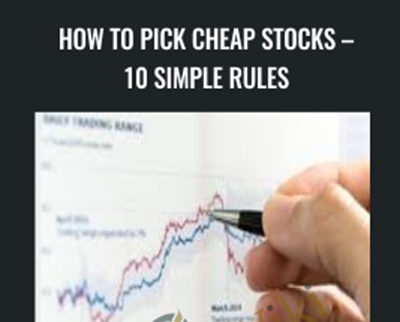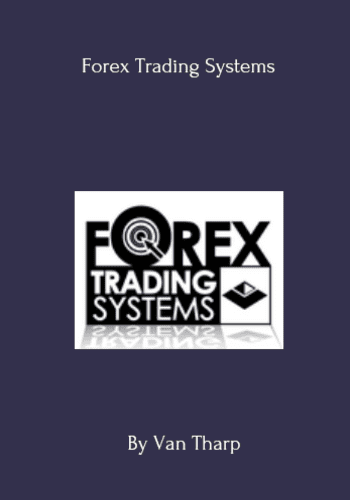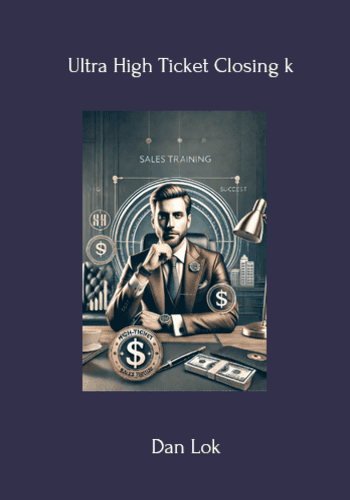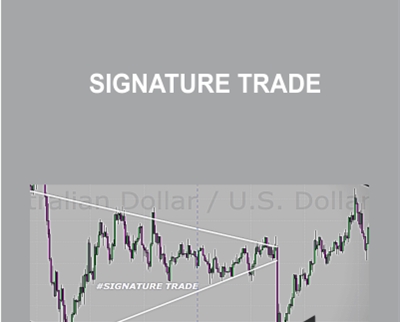How To Pick Cheap Stocks -10 Simple Rules – Joe Marwood
Original price was: $24.00.$12.00Current price is: $12.00.
How To Pick Cheap Stocks -10 Simple Rules – Joe Marwood Download. What you’ll learn
Learn how to scan and find cheap value stocks.
Learn 10 rules for succ…
Salepage link: At HERE. Archive:
What you’ll learn
- Learn how to scan and find cheap value stocks.
- Learn 10 rules for successful stock selection.
- Learn to make confident investment decisions in the stock market and manage a portfolio of shares.
- Learn to backtest and trade a strategy that has produced over 20% annual returns since 2000.
Requirements
- This course is suitable for beginners as well as intermediate and advanced investors. You are expected to know some basic financial terminology, however, a glossary is also provided.
Description
Whether you’re an experienced stock market investor or you’re looking to buy stocks for the very first time, this course will show you a hassle-free way to find deep value investments.
The Marwood Value model is an original quantitative investing strategy that I developed to select cheap stocks.
If you don’t take this course today, you might never realise the potential to be gained from compounding your wealth in the stock market.
Recent performance
Just recently, the Marwood Value system has produced some outstanding trades on stocks trading on US exchanges.
For example, the model recently picked out Shanda Games Limited (GAME). GAME is a Chinese technology company that traded on the Nasdaq. I wrote about the company in a Seeking Alpha article and said how the company had been selected by the model for outperformance.
Then, on the 3rd April, it was announced the company would be taken over in a $1.9 billion deal. Shares immediately jumped to $6.80, giving a 19% gain in less than a month.
There have been many other examples too. This is a model that finds cheap stocks trading below their intrinsic value. Stocks that often experience a rapid turnaround of fortune or get taken over by larger companies.
Introduction To Quantitative Value Investing
This Marwood Value Model is based around 10 key rules for buying and just one rule for selling.
Of course, the rules are not simply plucked out of thin air. They are grounded in the principles of successful value investing and historical performance. They take their cues from academic research and align with the viewpoints of successful value investors such as Warren Buffett, Benjamin Graham, Peter Lynch and others.
The nature of this strategy makes it both highly flexible and easy to use. Entries and exits are made every two weeks, which means this is another stock market strategy that requires very little maintenance.
It is the perfect strategy to combine with another system, such as a trend following system, a short-term trading system, or a growth investing system.
By using more than one system together, it is possible to reduce drawdown and risk – so long as those systems are significantly different from one another.
Impressive Historical Performance
Using the latest analytical software, I take the 10 value investing rules and I apply them to historical stock market data. The results are recorded live and show an impressive 19 percentage point outperformance against the benchmark S&P 500.
Over the last 15 years, this strategy was shown to produce annual returns of 21.50% with a maximum drawdown of just 30% and a Sharpe ratio of 0.90. Meanwhile, the S&P 500 has only been able to return 2.28% annually in that time.
How the strategy came about
The actual story about how the Marwood Value Model came about is not a random one. In fact, rules for the strategy came about after I realised that many of my best performing stock picks all shared the same inherent characteristics.
Characteristics such as strong cash generation, low price-to-book values and consistent earnings growth. To my delight, when I put these simple rules into the Portfolio simulator to test, they worked amazingly well. First time!
I then spent some time tweaking and fine-tuning the rules, particularly the exit, and I found that the most success came from keeping everything simple and straightforward.
What you will need
The course details the full rules to the strategy; when to buy, when to sell, and how much to buy and sell. But it also explains each rule in detail, so you know why it’s being used and what makes the rule important.
In terms of software, the strategy is run on the simulator from Portfolio123. This is an institutional quality simulator that’s used by the likes of Merrill Lynch, Bank of America and the University of Columbia. It’s a high powered and expensive tool that costs around $200 a month to use.
However, the Marwood Value Model has been especially designed to be used without need for any expensive tools. As I show on the course, the model can be set up and run using free stock screeners that are found online.
As a result, this is a strategy that anyone can learn from, use, and enjoy.
If you are interested in building a portfolio of winning investments and you’re tired of getting burned in the stock market, I strongly recommend you take a look at this course.
And remember, if you are not completely satisfied for any reason, you have a 30-day money back guarantee from Udemy.
I’m sure you will great value in this course and I truly hope to see you do well with your investments. See you on the other side.
Who this course is for:
- This course is for anyone wanting to find cheap, value investments.
- The course is suitable for long term investors, medium term traders, beginners, and even retirees.
- The course is ideal for investors or traders looking to diversify with an alternate investment strategy.
Course content
Before We Begin
- Important disclaimer
- How to take this course and get in touch.
- What’s this course all about?
- Introduction
Goals, Tools & Some Theory
- Goals of the course.
- Don’t forget to use closed captions (CC) on the course videos
- Some theory & why you need investing rules.
- Tools we will be using.
- Evidence of value investing and principles.
- Our benchmark. How to measure performance.
- The S&P 500 is a trading system. David Harding from Winton Capital speaks.
- Benjamin Graham’s investing rules.
Getting Started
- A word about data mining and optimisation.
- Transaction costs, survivorship-bias and other settings.
The 10 Rules
- Rule zero: liquidity.
- Rule one: market cap.
- Rule two: minimum price filter.
- Rule three: PE ratio.
- Rule four: forward PE ratio.
- Rule five: price-to-sales.
- Rule six: price-to-book.
- Rule seven: price-to-free-cash-flow
- Rule eight: current ratio.
- Rule nine: 5-year EPS growth.
- Rule ten: momentum.
When To Sell
- Sell rule one.
Risk & Ranking & Finer Details
- Risk: how many shares to buy.
- Extra important details.
- Ranking criteria: how to choose between stocks.
- Capital requirements.
Back-Testing The Rules
- Setting up the simulator with the 10 rules.
- Back-testing the rules on historical data: in-sample and out-of-sample
- Full sample test: 2000 – 2015.
- Performance Reports & Statistics.
Stres-Testing
- Stress-testing the strategy
Some Finer Points
- Strategy advantages & disadvantages.
- Introducing ETFs into the mix.
- Marwood Value: loose version
Extra Rules (Qualitative)
- Rule 11: understand the business.
- Rule 12: insider transactions.
- Rule 13: consistency of earnings.
- Rule 14: keep a macro view.
- Rule 15: don’t put all your eggs in one basket.
- Rule 16: profit warnings & chart patterns.
- Rule 17: don’t gamble.
- Rule 18: analyse your performance.
- Rule 19: look for compelling story lines.
- Rule 20: ignore the noise.
Going Live
- How to run the strategy live
- How to trade the strategy live (in plain language)
- Extra considerations: watch out for these!
- Tax implications.
Conclusion
- Conclusion
Additional Material
- Clarification on the sell rule.
- Should you wait for the next market crash? Buy-and-hold facts.
- Value Investing Rules eBook
Resources
- Recommended reading.
- Music credits.
Bonus Lecture
- New Trading Systems Revealed
Here's an overview of the prominent keywords and a list of famous authors:
Business and Sales: Explore business strategies, sales skills, entrepreneurship, and brand-building from authors like Joe Wicks, Jillian Michaels, and Tony Horton.
Sports and Fitness: Enhance athleticism, improve health and fitness with guidance from experts like Shaun T, Kayla Itsines, and Yoga with Adriene.
Personal Development: Develop communication skills, time management, creative thinking, and enhance self-awareness from authors like Gretchen Rubin, Simon Sinek, and Marie Kondo.
Technology and Coding: Learn about artificial intelligence, data analytics, programming, and blockchain technology from thought leaders like Neil deGrasse Tyson, Amy Cuddy, and Malcolm Gladwell.
Lifestyle and Wellness: Discover courses on holistic health, yoga, and healthy living from authors like Elizabeth Gilbert, Bill Nye, and Tracy Anderson.
Art and Creativity: Explore the world of art, creativity, and painting with guidance from renowned artists like Bob Ross and others.
All the courses on WSOlib are led by top authors and experts in their respective fields. Rest assured that the knowledge and skills you acquire are reliable and highly applicable.
Specification: How To Pick Cheap Stocks -10 Simple Rules – Joe Marwood
|
User Reviews
Only logged in customers who have purchased this product may leave a review.

Original price was: $24.00.$12.00Current price is: $12.00.












There are no reviews yet.